Financial Analysis and Strategies for the Hospitality Industry
VerifiedAdded on 2019/12/28
|26
|7503
|44
Report
AI Summary
This report delves into the financial aspects of the hospitality industry, focusing on the fictional company, Magrat. It begins by exploring sources of finance, including equity shares, debt financing, and retained earnings, relevant to both general business and service industries. The report then examines methods of generating income for large chain restaurants, differentiating between core business revenue (food, beverage, packages) and non-core business revenue (investments, interest). Task 2 analyzes cost elements, gross profit, and selling prices, categorizing costs as material, labor, and expenses, both direct and indirect. The report then moves to methods of controlling stock and cash. Task 3 discusses budgetary control processes and variance analysis. Task 4 focuses on the sources and structure of the trial balance, evaluating business accounts, adjustments, and ratios, culminating in strategic recommendations. Finally, Task 5 covers the categorization of costs as fixed, variable, and semi-variable, along with break-even point analysis in units and value, determining the number of units required to meet a target profit. The conclusion summarizes key findings and recommendations, with a bibliography provided for reference.
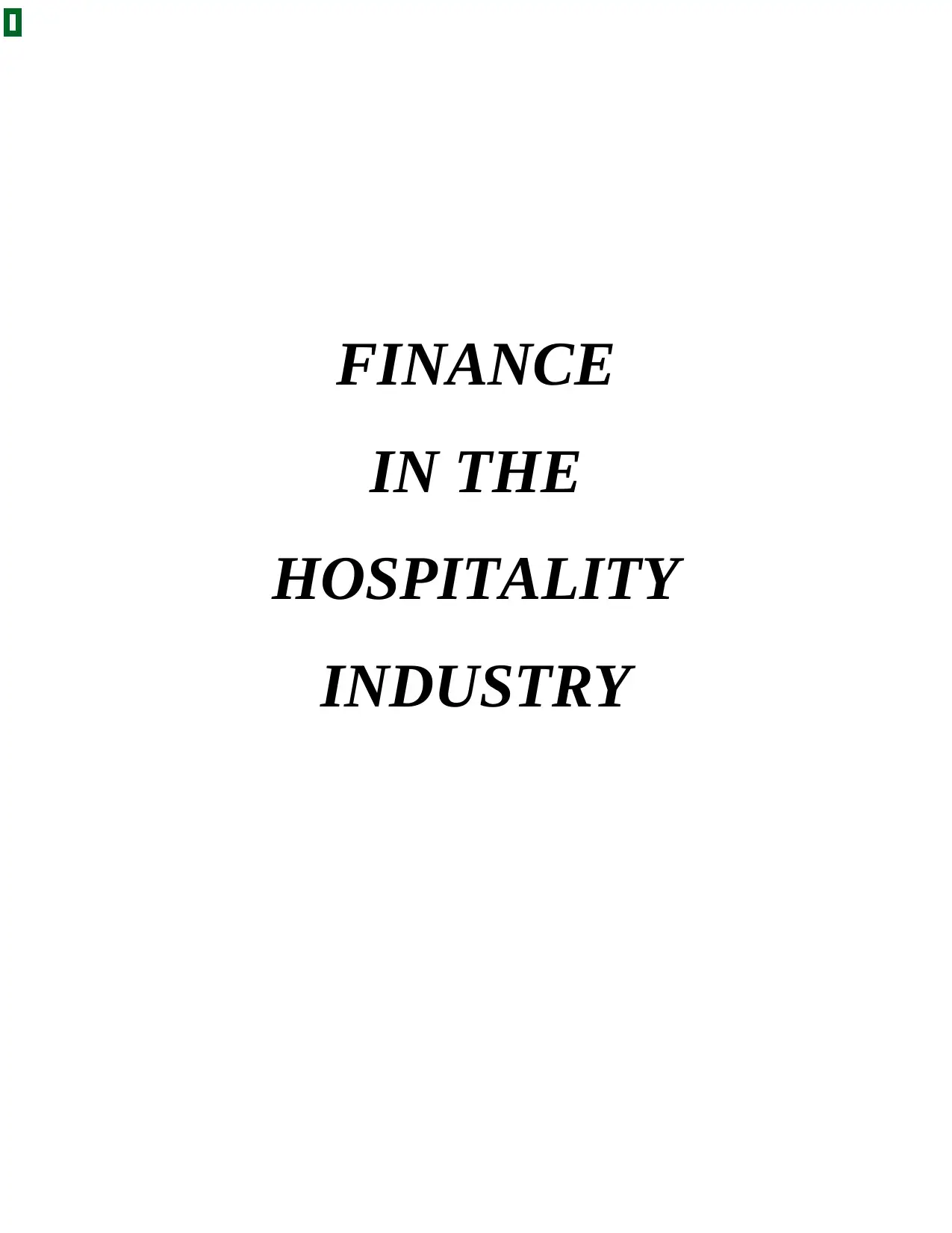
FINANCE
IN THE
HOSPITALITY
INDUSTRY
IN THE
HOSPITALITY
INDUSTRY
Paraphrase This Document
Need a fresh take? Get an instant paraphrase of this document with our AI Paraphraser
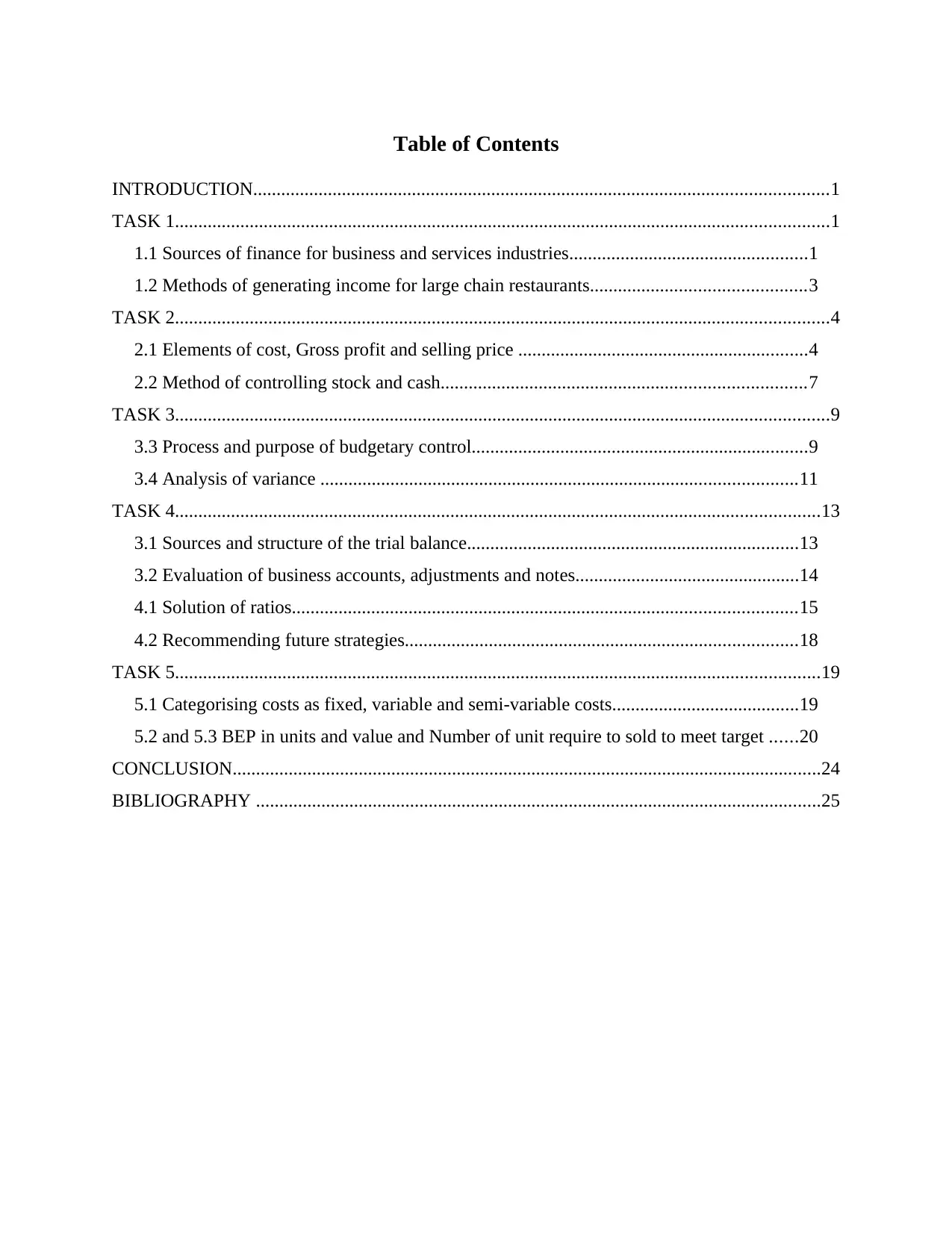
Table of Contents
INTRODUCTION...........................................................................................................................1
TASK 1............................................................................................................................................1
1.1 Sources of finance for business and services industries...................................................1
1.2 Methods of generating income for large chain restaurants..............................................3
TASK 2............................................................................................................................................4
2.1 Elements of cost, Gross profit and selling price ..............................................................4
2.2 Method of controlling stock and cash..............................................................................7
TASK 3............................................................................................................................................9
3.3 Process and purpose of budgetary control........................................................................9
3.4 Analysis of variance ......................................................................................................11
TASK 4..........................................................................................................................................13
3.1 Sources and structure of the trial balance.......................................................................13
3.2 Evaluation of business accounts, adjustments and notes................................................14
4.1 Solution of ratios............................................................................................................15
4.2 Recommending future strategies....................................................................................18
TASK 5..........................................................................................................................................19
5.1 Categorising costs as fixed, variable and semi-variable costs........................................19
5.2 and 5.3 BEP in units and value and Number of unit require to sold to meet target ......20
CONCLUSION..............................................................................................................................24
BIBLIOGRAPHY .........................................................................................................................25
INTRODUCTION...........................................................................................................................1
TASK 1............................................................................................................................................1
1.1 Sources of finance for business and services industries...................................................1
1.2 Methods of generating income for large chain restaurants..............................................3
TASK 2............................................................................................................................................4
2.1 Elements of cost, Gross profit and selling price ..............................................................4
2.2 Method of controlling stock and cash..............................................................................7
TASK 3............................................................................................................................................9
3.3 Process and purpose of budgetary control........................................................................9
3.4 Analysis of variance ......................................................................................................11
TASK 4..........................................................................................................................................13
3.1 Sources and structure of the trial balance.......................................................................13
3.2 Evaluation of business accounts, adjustments and notes................................................14
4.1 Solution of ratios............................................................................................................15
4.2 Recommending future strategies....................................................................................18
TASK 5..........................................................................................................................................19
5.1 Categorising costs as fixed, variable and semi-variable costs........................................19
5.2 and 5.3 BEP in units and value and Number of unit require to sold to meet target ......20
CONCLUSION..............................................................................................................................24
BIBLIOGRAPHY .........................................................................................................................25
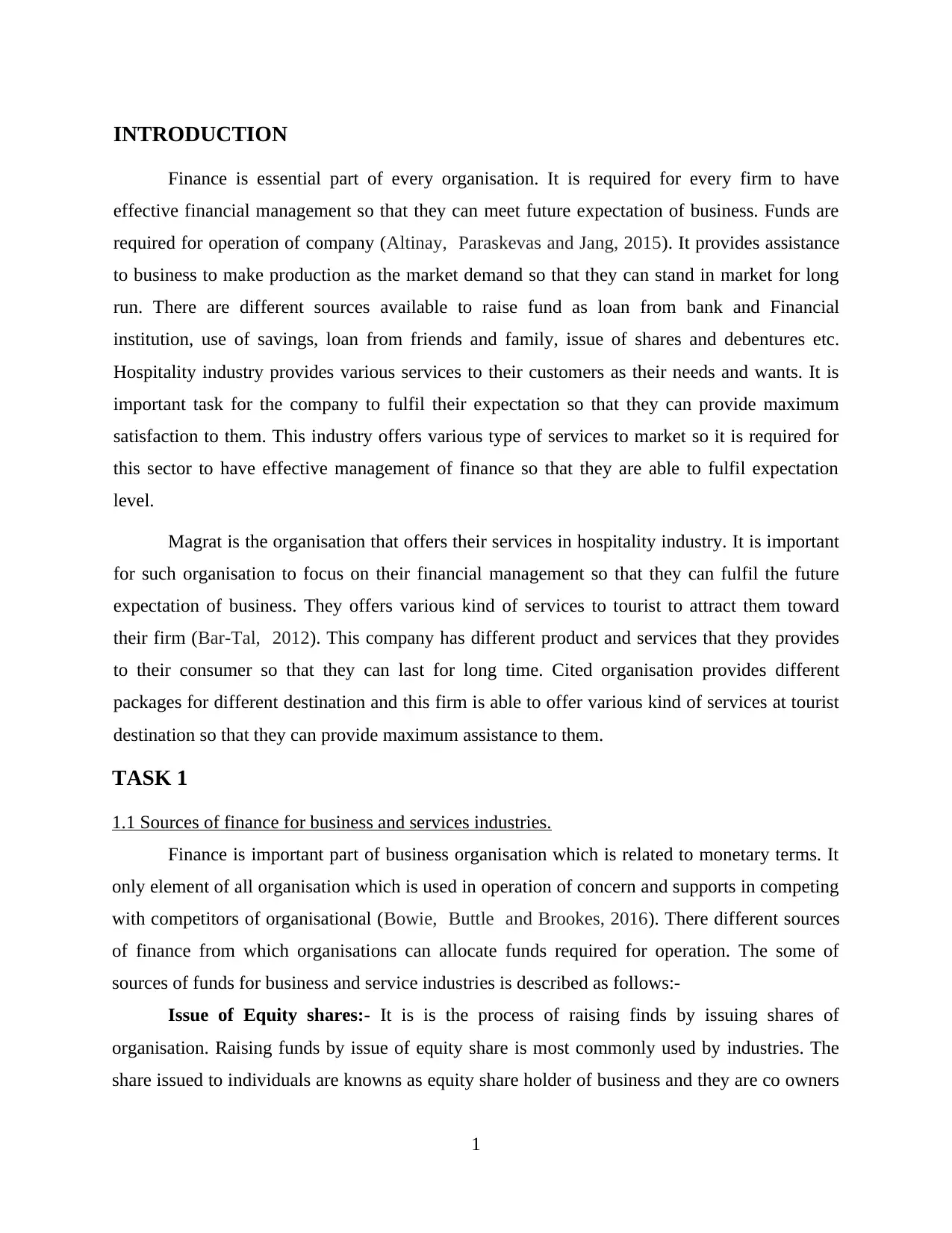
INTRODUCTION
Finance is essential part of every organisation. It is required for every firm to have
effective financial management so that they can meet future expectation of business. Funds are
required for operation of company (Altinay, Paraskevas and Jang, 2015). It provides assistance
to business to make production as the market demand so that they can stand in market for long
run. There are different sources available to raise fund as loan from bank and Financial
institution, use of savings, loan from friends and family, issue of shares and debentures etc.
Hospitality industry provides various services to their customers as their needs and wants. It is
important task for the company to fulfil their expectation so that they can provide maximum
satisfaction to them. This industry offers various type of services to market so it is required for
this sector to have effective management of finance so that they are able to fulfil expectation
level.
Magrat is the organisation that offers their services in hospitality industry. It is important
for such organisation to focus on their financial management so that they can fulfil the future
expectation of business. They offers various kind of services to tourist to attract them toward
their firm (Bar-Tal, 2012). This company has different product and services that they provides
to their consumer so that they can last for long time. Cited organisation provides different
packages for different destination and this firm is able to offer various kind of services at tourist
destination so that they can provide maximum assistance to them.
TASK 1
1.1 Sources of finance for business and services industries.
Finance is important part of business organisation which is related to monetary terms. It
only element of all organisation which is used in operation of concern and supports in competing
with competitors of organisational (Bowie, Buttle and Brookes, 2016). There different sources
of finance from which organisations can allocate funds required for operation. The some of
sources of funds for business and service industries is described as follows:-
Issue of Equity shares:- It is is the process of raising finds by issuing shares of
organisation. Raising funds by issue of equity share is most commonly used by industries. The
share issued to individuals are knowns as equity share holder of business and they are co owners
1
Finance is essential part of every organisation. It is required for every firm to have
effective financial management so that they can meet future expectation of business. Funds are
required for operation of company (Altinay, Paraskevas and Jang, 2015). It provides assistance
to business to make production as the market demand so that they can stand in market for long
run. There are different sources available to raise fund as loan from bank and Financial
institution, use of savings, loan from friends and family, issue of shares and debentures etc.
Hospitality industry provides various services to their customers as their needs and wants. It is
important task for the company to fulfil their expectation so that they can provide maximum
satisfaction to them. This industry offers various type of services to market so it is required for
this sector to have effective management of finance so that they are able to fulfil expectation
level.
Magrat is the organisation that offers their services in hospitality industry. It is important
for such organisation to focus on their financial management so that they can fulfil the future
expectation of business. They offers various kind of services to tourist to attract them toward
their firm (Bar-Tal, 2012). This company has different product and services that they provides
to their consumer so that they can last for long time. Cited organisation provides different
packages for different destination and this firm is able to offer various kind of services at tourist
destination so that they can provide maximum assistance to them.
TASK 1
1.1 Sources of finance for business and services industries.
Finance is important part of business organisation which is related to monetary terms. It
only element of all organisation which is used in operation of concern and supports in competing
with competitors of organisational (Bowie, Buttle and Brookes, 2016). There different sources
of finance from which organisations can allocate funds required for operation. The some of
sources of funds for business and service industries is described as follows:-
Issue of Equity shares:- It is is the process of raising finds by issuing shares of
organisation. Raising funds by issue of equity share is most commonly used by industries. The
share issued to individuals are knowns as equity share holder of business and they are co owners
1
⊘ This is a preview!⊘
Do you want full access?
Subscribe today to unlock all pages.

Trusted by 1+ million students worldwide
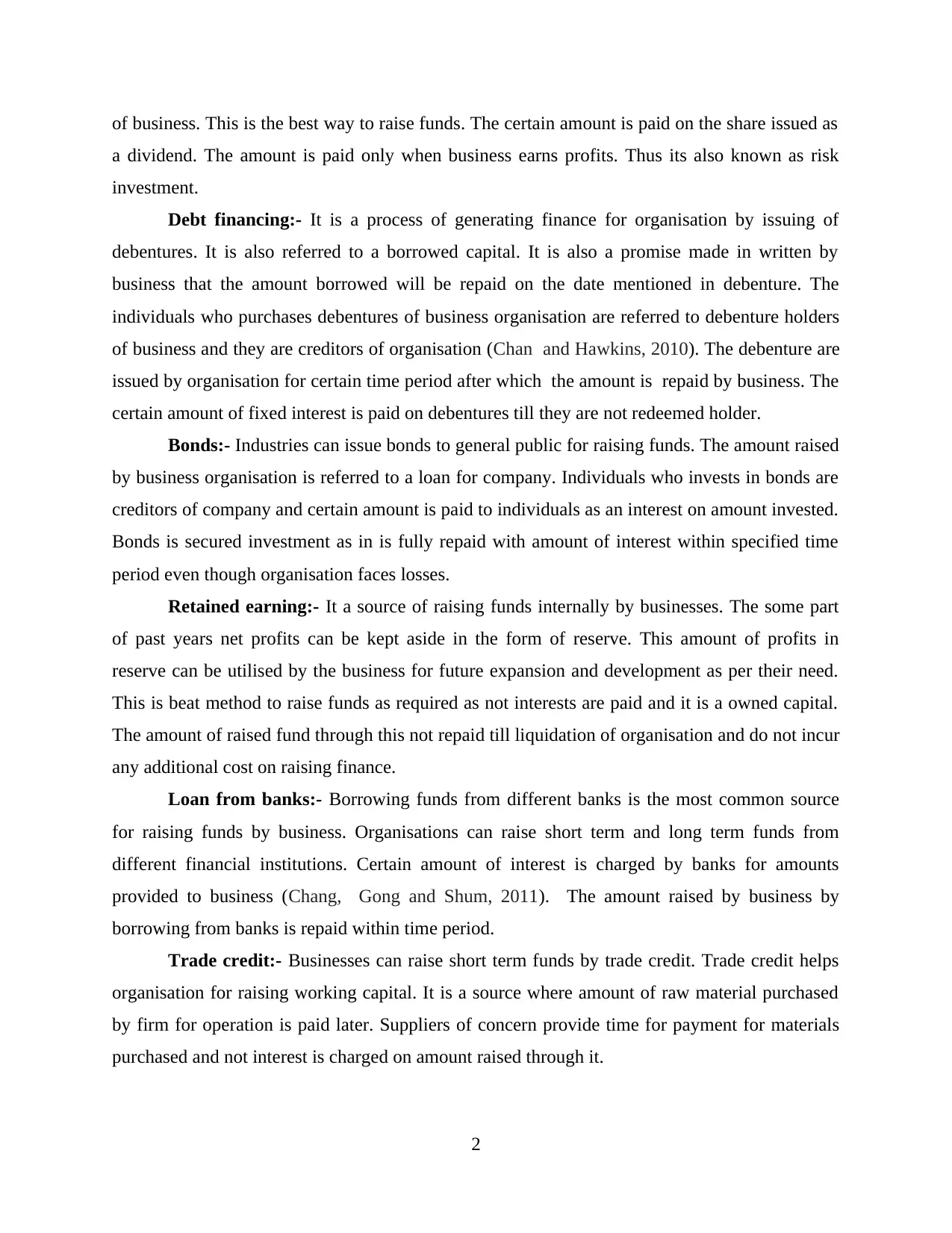
of business. This is the best way to raise funds. The certain amount is paid on the share issued as
a dividend. The amount is paid only when business earns profits. Thus its also known as risk
investment.
Debt financing:- It is a process of generating finance for organisation by issuing of
debentures. It is also referred to a borrowed capital. It is also a promise made in written by
business that the amount borrowed will be repaid on the date mentioned in debenture. The
individuals who purchases debentures of business organisation are referred to debenture holders
of business and they are creditors of organisation (Chan and Hawkins, 2010). The debenture are
issued by organisation for certain time period after which the amount is repaid by business. The
certain amount of fixed interest is paid on debentures till they are not redeemed holder.
Bonds:- Industries can issue bonds to general public for raising funds. The amount raised
by business organisation is referred to a loan for company. Individuals who invests in bonds are
creditors of company and certain amount is paid to individuals as an interest on amount invested.
Bonds is secured investment as in is fully repaid with amount of interest within specified time
period even though organisation faces losses.
Retained earning:- It a source of raising funds internally by businesses. The some part
of past years net profits can be kept aside in the form of reserve. This amount of profits in
reserve can be utilised by the business for future expansion and development as per their need.
This is beat method to raise funds as required as not interests are paid and it is a owned capital.
The amount of raised fund through this not repaid till liquidation of organisation and do not incur
any additional cost on raising finance.
Loan from banks:- Borrowing funds from different banks is the most common source
for raising funds by business. Organisations can raise short term and long term funds from
different financial institutions. Certain amount of interest is charged by banks for amounts
provided to business (Chang, Gong and Shum, 2011). The amount raised by business by
borrowing from banks is repaid within time period.
Trade credit:- Businesses can raise short term funds by trade credit. Trade credit helps
organisation for raising working capital. It is a source where amount of raw material purchased
by firm for operation is paid later. Suppliers of concern provide time for payment for materials
purchased and not interest is charged on amount raised through it.
2
a dividend. The amount is paid only when business earns profits. Thus its also known as risk
investment.
Debt financing:- It is a process of generating finance for organisation by issuing of
debentures. It is also referred to a borrowed capital. It is also a promise made in written by
business that the amount borrowed will be repaid on the date mentioned in debenture. The
individuals who purchases debentures of business organisation are referred to debenture holders
of business and they are creditors of organisation (Chan and Hawkins, 2010). The debenture are
issued by organisation for certain time period after which the amount is repaid by business. The
certain amount of fixed interest is paid on debentures till they are not redeemed holder.
Bonds:- Industries can issue bonds to general public for raising funds. The amount raised
by business organisation is referred to a loan for company. Individuals who invests in bonds are
creditors of company and certain amount is paid to individuals as an interest on amount invested.
Bonds is secured investment as in is fully repaid with amount of interest within specified time
period even though organisation faces losses.
Retained earning:- It a source of raising funds internally by businesses. The some part
of past years net profits can be kept aside in the form of reserve. This amount of profits in
reserve can be utilised by the business for future expansion and development as per their need.
This is beat method to raise funds as required as not interests are paid and it is a owned capital.
The amount of raised fund through this not repaid till liquidation of organisation and do not incur
any additional cost on raising finance.
Loan from banks:- Borrowing funds from different banks is the most common source
for raising funds by business. Organisations can raise short term and long term funds from
different financial institutions. Certain amount of interest is charged by banks for amounts
provided to business (Chang, Gong and Shum, 2011). The amount raised by business by
borrowing from banks is repaid within time period.
Trade credit:- Businesses can raise short term funds by trade credit. Trade credit helps
organisation for raising working capital. It is a source where amount of raw material purchased
by firm for operation is paid later. Suppliers of concern provide time for payment for materials
purchased and not interest is charged on amount raised through it.
2
Paraphrase This Document
Need a fresh take? Get an instant paraphrase of this document with our AI Paraphraser
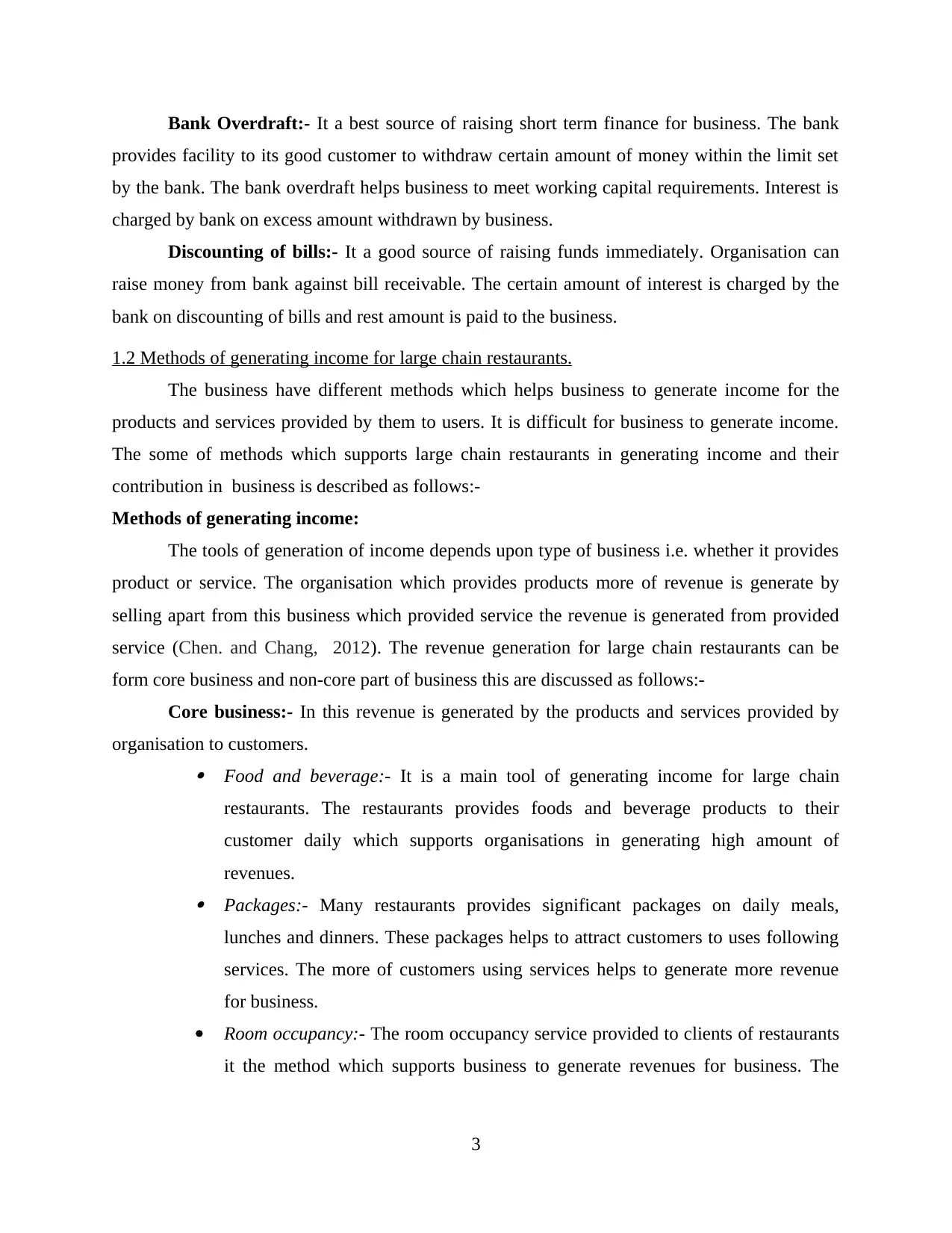
Bank Overdraft:- It a best source of raising short term finance for business. The bank
provides facility to its good customer to withdraw certain amount of money within the limit set
by the bank. The bank overdraft helps business to meet working capital requirements. Interest is
charged by bank on excess amount withdrawn by business.
Discounting of bills:- It a good source of raising funds immediately. Organisation can
raise money from bank against bill receivable. The certain amount of interest is charged by the
bank on discounting of bills and rest amount is paid to the business.
1.2 Methods of generating income for large chain restaurants.
The business have different methods which helps business to generate income for the
products and services provided by them to users. It is difficult for business to generate income.
The some of methods which supports large chain restaurants in generating income and their
contribution in business is described as follows:-
Methods of generating income:
The tools of generation of income depends upon type of business i.e. whether it provides
product or service. The organisation which provides products more of revenue is generate by
selling apart from this business which provided service the revenue is generated from provided
service (Chen. and Chang, 2012). The revenue generation for large chain restaurants can be
form core business and non-core part of business this are discussed as follows:-
Core business:- In this revenue is generated by the products and services provided by
organisation to customers.
Food and beverage:- It is a main tool of generating income for large chain
restaurants. The restaurants provides foods and beverage products to their
customer daily which supports organisations in generating high amount of
revenues.
Packages:- Many restaurants provides significant packages on daily meals,
lunches and dinners. These packages helps to attract customers to uses following
services. The more of customers using services helps to generate more revenue
for business.
Room occupancy:- The room occupancy service provided to clients of restaurants
it the method which supports business to generate revenues for business. The
3
provides facility to its good customer to withdraw certain amount of money within the limit set
by the bank. The bank overdraft helps business to meet working capital requirements. Interest is
charged by bank on excess amount withdrawn by business.
Discounting of bills:- It a good source of raising funds immediately. Organisation can
raise money from bank against bill receivable. The certain amount of interest is charged by the
bank on discounting of bills and rest amount is paid to the business.
1.2 Methods of generating income for large chain restaurants.
The business have different methods which helps business to generate income for the
products and services provided by them to users. It is difficult for business to generate income.
The some of methods which supports large chain restaurants in generating income and their
contribution in business is described as follows:-
Methods of generating income:
The tools of generation of income depends upon type of business i.e. whether it provides
product or service. The organisation which provides products more of revenue is generate by
selling apart from this business which provided service the revenue is generated from provided
service (Chen. and Chang, 2012). The revenue generation for large chain restaurants can be
form core business and non-core part of business this are discussed as follows:-
Core business:- In this revenue is generated by the products and services provided by
organisation to customers.
Food and beverage:- It is a main tool of generating income for large chain
restaurants. The restaurants provides foods and beverage products to their
customer daily which supports organisations in generating high amount of
revenues.
Packages:- Many restaurants provides significant packages on daily meals,
lunches and dinners. These packages helps to attract customers to uses following
services. The more of customers using services helps to generate more revenue
for business.
Room occupancy:- The room occupancy service provided to clients of restaurants
it the method which supports business to generate revenues for business. The
3
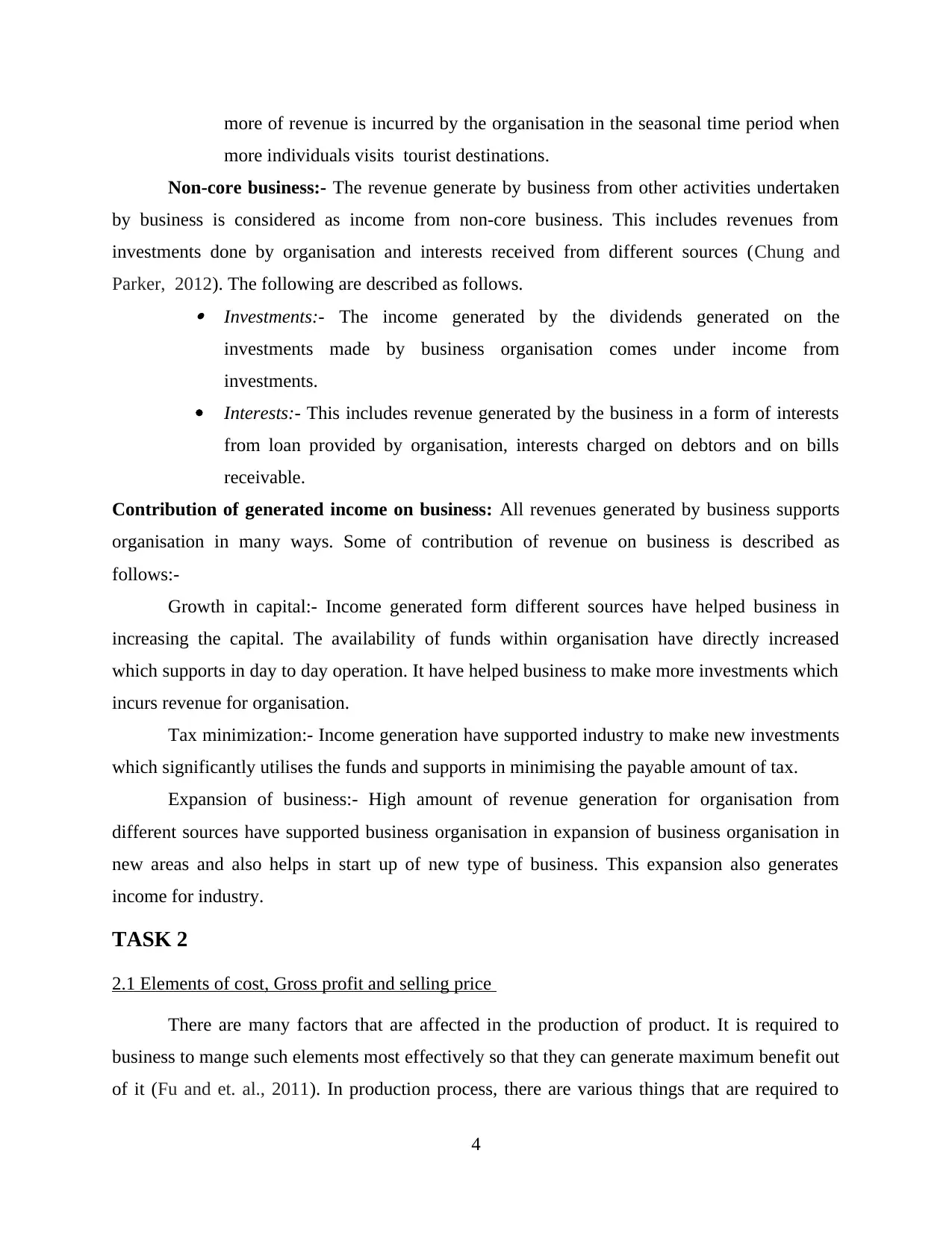
more of revenue is incurred by the organisation in the seasonal time period when
more individuals visits tourist destinations.
Non-core business:- The revenue generate by business from other activities undertaken
by business is considered as income from non-core business. This includes revenues from
investments done by organisation and interests received from different sources (Chung and
Parker, 2012). The following are described as follows.
Investments:- The income generated by the dividends generated on the
investments made by business organisation comes under income from
investments.
Interests:- This includes revenue generated by the business in a form of interests
from loan provided by organisation, interests charged on debtors and on bills
receivable.
Contribution of generated income on business: All revenues generated by business supports
organisation in many ways. Some of contribution of revenue on business is described as
follows:-
Growth in capital:- Income generated form different sources have helped business in
increasing the capital. The availability of funds within organisation have directly increased
which supports in day to day operation. It have helped business to make more investments which
incurs revenue for organisation.
Tax minimization:- Income generation have supported industry to make new investments
which significantly utilises the funds and supports in minimising the payable amount of tax.
Expansion of business:- High amount of revenue generation for organisation from
different sources have supported business organisation in expansion of business organisation in
new areas and also helps in start up of new type of business. This expansion also generates
income for industry.
TASK 2
2.1 Elements of cost, Gross profit and selling price
There are many factors that are affected in the production of product. It is required to
business to mange such elements most effectively so that they can generate maximum benefit out
of it (Fu and et. al., 2011). In production process, there are various things that are required to
4
more individuals visits tourist destinations.
Non-core business:- The revenue generate by business from other activities undertaken
by business is considered as income from non-core business. This includes revenues from
investments done by organisation and interests received from different sources (Chung and
Parker, 2012). The following are described as follows.
Investments:- The income generated by the dividends generated on the
investments made by business organisation comes under income from
investments.
Interests:- This includes revenue generated by the business in a form of interests
from loan provided by organisation, interests charged on debtors and on bills
receivable.
Contribution of generated income on business: All revenues generated by business supports
organisation in many ways. Some of contribution of revenue on business is described as
follows:-
Growth in capital:- Income generated form different sources have helped business in
increasing the capital. The availability of funds within organisation have directly increased
which supports in day to day operation. It have helped business to make more investments which
incurs revenue for organisation.
Tax minimization:- Income generation have supported industry to make new investments
which significantly utilises the funds and supports in minimising the payable amount of tax.
Expansion of business:- High amount of revenue generation for organisation from
different sources have supported business organisation in expansion of business organisation in
new areas and also helps in start up of new type of business. This expansion also generates
income for industry.
TASK 2
2.1 Elements of cost, Gross profit and selling price
There are many factors that are affected in the production of product. It is required to
business to mange such elements most effectively so that they can generate maximum benefit out
of it (Fu and et. al., 2011). In production process, there are various things that are required to
4
⊘ This is a preview!⊘
Do you want full access?
Subscribe today to unlock all pages.

Trusted by 1+ million students worldwide
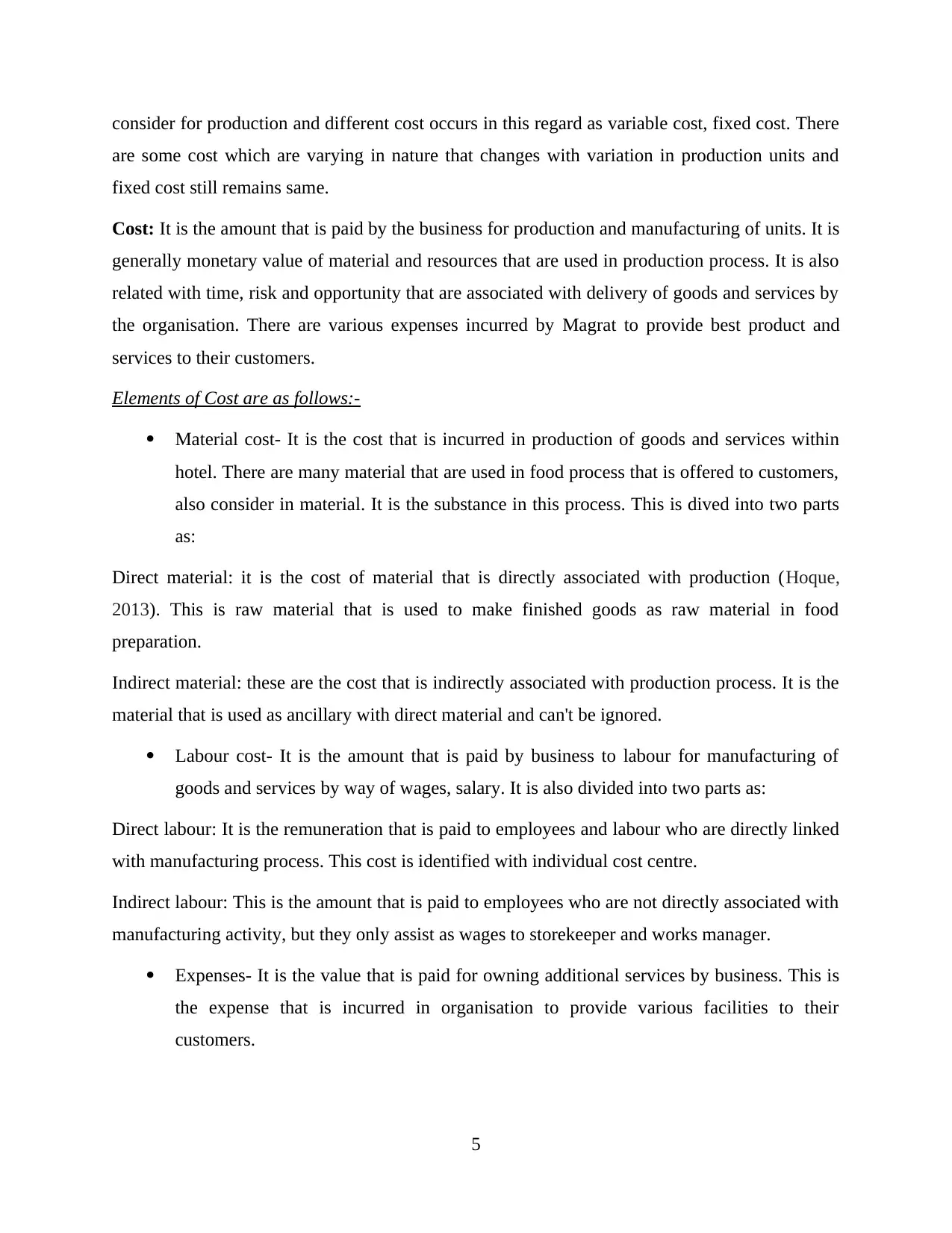
consider for production and different cost occurs in this regard as variable cost, fixed cost. There
are some cost which are varying in nature that changes with variation in production units and
fixed cost still remains same.
Cost: It is the amount that is paid by the business for production and manufacturing of units. It is
generally monetary value of material and resources that are used in production process. It is also
related with time, risk and opportunity that are associated with delivery of goods and services by
the organisation. There are various expenses incurred by Magrat to provide best product and
services to their customers.
Elements of Cost are as follows:-
Material cost- It is the cost that is incurred in production of goods and services within
hotel. There are many material that are used in food process that is offered to customers,
also consider in material. It is the substance in this process. This is dived into two parts
as:
Direct material: it is the cost of material that is directly associated with production (Hoque,
2013). This is raw material that is used to make finished goods as raw material in food
preparation.
Indirect material: these are the cost that is indirectly associated with production process. It is the
material that is used as ancillary with direct material and can't be ignored.
Labour cost- It is the amount that is paid by business to labour for manufacturing of
goods and services by way of wages, salary. It is also divided into two parts as:
Direct labour: It is the remuneration that is paid to employees and labour who are directly linked
with manufacturing process. This cost is identified with individual cost centre.
Indirect labour: This is the amount that is paid to employees who are not directly associated with
manufacturing activity, but they only assist as wages to storekeeper and works manager.
Expenses- It is the value that is paid for owning additional services by business. This is
the expense that is incurred in organisation to provide various facilities to their
customers.
5
are some cost which are varying in nature that changes with variation in production units and
fixed cost still remains same.
Cost: It is the amount that is paid by the business for production and manufacturing of units. It is
generally monetary value of material and resources that are used in production process. It is also
related with time, risk and opportunity that are associated with delivery of goods and services by
the organisation. There are various expenses incurred by Magrat to provide best product and
services to their customers.
Elements of Cost are as follows:-
Material cost- It is the cost that is incurred in production of goods and services within
hotel. There are many material that are used in food process that is offered to customers,
also consider in material. It is the substance in this process. This is dived into two parts
as:
Direct material: it is the cost of material that is directly associated with production (Hoque,
2013). This is raw material that is used to make finished goods as raw material in food
preparation.
Indirect material: these are the cost that is indirectly associated with production process. It is the
material that is used as ancillary with direct material and can't be ignored.
Labour cost- It is the amount that is paid by business to labour for manufacturing of
goods and services by way of wages, salary. It is also divided into two parts as:
Direct labour: It is the remuneration that is paid to employees and labour who are directly linked
with manufacturing process. This cost is identified with individual cost centre.
Indirect labour: This is the amount that is paid to employees who are not directly associated with
manufacturing activity, but they only assist as wages to storekeeper and works manager.
Expenses- It is the value that is paid for owning additional services by business. This is
the expense that is incurred in organisation to provide various facilities to their
customers.
5
Paraphrase This Document
Need a fresh take? Get an instant paraphrase of this document with our AI Paraphraser
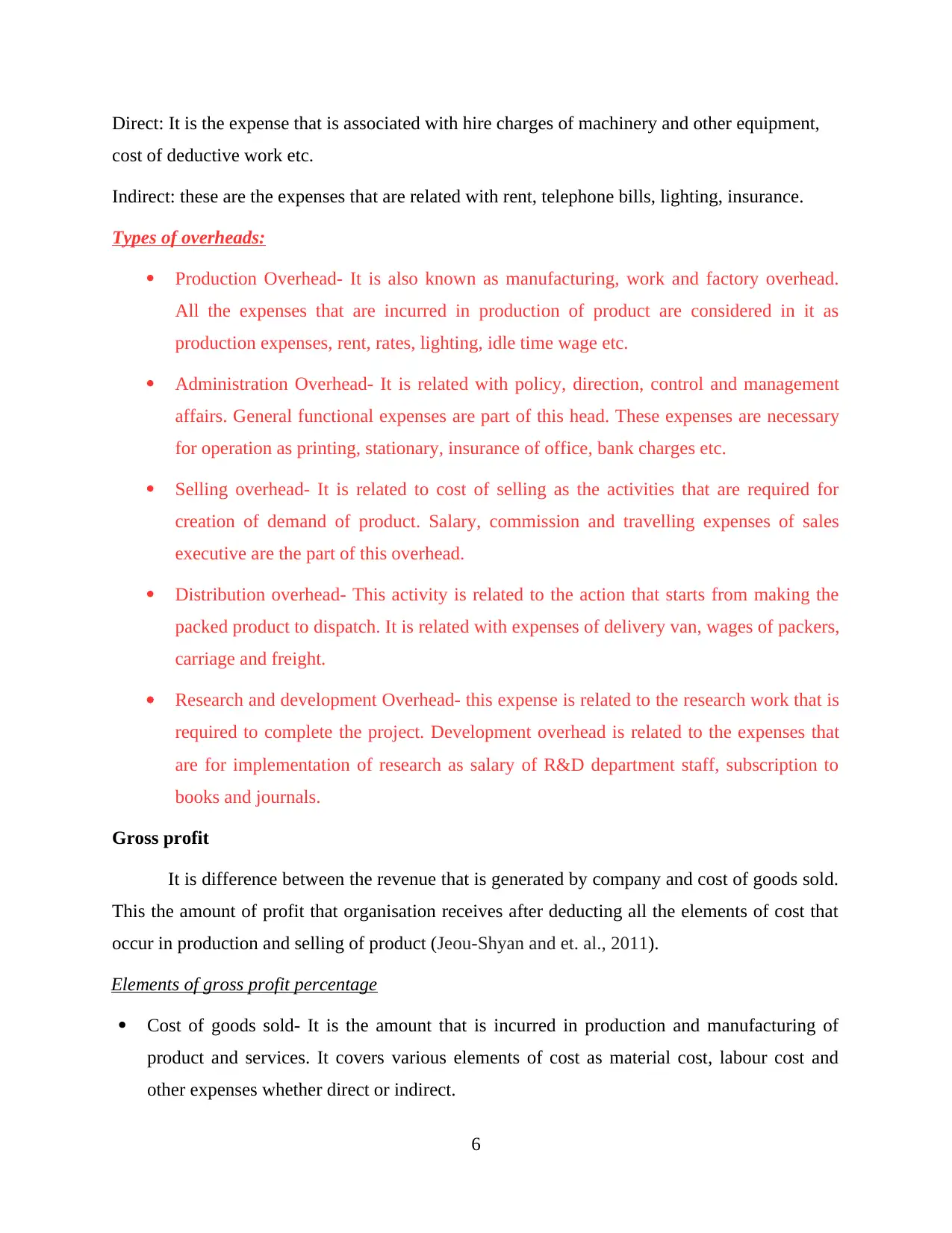
Direct: It is the expense that is associated with hire charges of machinery and other equipment,
cost of deductive work etc.
Indirect: these are the expenses that are related with rent, telephone bills, lighting, insurance.
Types of overheads:
Production Overhead- It is also known as manufacturing, work and factory overhead.
All the expenses that are incurred in production of product are considered in it as
production expenses, rent, rates, lighting, idle time wage etc.
Administration Overhead- It is related with policy, direction, control and management
affairs. General functional expenses are part of this head. These expenses are necessary
for operation as printing, stationary, insurance of office, bank charges etc.
Selling overhead- It is related to cost of selling as the activities that are required for
creation of demand of product. Salary, commission and travelling expenses of sales
executive are the part of this overhead.
Distribution overhead- This activity is related to the action that starts from making the
packed product to dispatch. It is related with expenses of delivery van, wages of packers,
carriage and freight.
Research and development Overhead- this expense is related to the research work that is
required to complete the project. Development overhead is related to the expenses that
are for implementation of research as salary of R&D department staff, subscription to
books and journals.
Gross profit
It is difference between the revenue that is generated by company and cost of goods sold.
This the amount of profit that organisation receives after deducting all the elements of cost that
occur in production and selling of product (Jeou-Shyan and et. al., 2011).
Elements of gross profit percentage
Cost of goods sold- It is the amount that is incurred in production and manufacturing of
product and services. It covers various elements of cost as material cost, labour cost and
other expenses whether direct or indirect.
6
cost of deductive work etc.
Indirect: these are the expenses that are related with rent, telephone bills, lighting, insurance.
Types of overheads:
Production Overhead- It is also known as manufacturing, work and factory overhead.
All the expenses that are incurred in production of product are considered in it as
production expenses, rent, rates, lighting, idle time wage etc.
Administration Overhead- It is related with policy, direction, control and management
affairs. General functional expenses are part of this head. These expenses are necessary
for operation as printing, stationary, insurance of office, bank charges etc.
Selling overhead- It is related to cost of selling as the activities that are required for
creation of demand of product. Salary, commission and travelling expenses of sales
executive are the part of this overhead.
Distribution overhead- This activity is related to the action that starts from making the
packed product to dispatch. It is related with expenses of delivery van, wages of packers,
carriage and freight.
Research and development Overhead- this expense is related to the research work that is
required to complete the project. Development overhead is related to the expenses that
are for implementation of research as salary of R&D department staff, subscription to
books and journals.
Gross profit
It is difference between the revenue that is generated by company and cost of goods sold.
This the amount of profit that organisation receives after deducting all the elements of cost that
occur in production and selling of product (Jeou-Shyan and et. al., 2011).
Elements of gross profit percentage
Cost of goods sold- It is the amount that is incurred in production and manufacturing of
product and services. It covers various elements of cost as material cost, labour cost and
other expenses whether direct or indirect.
6
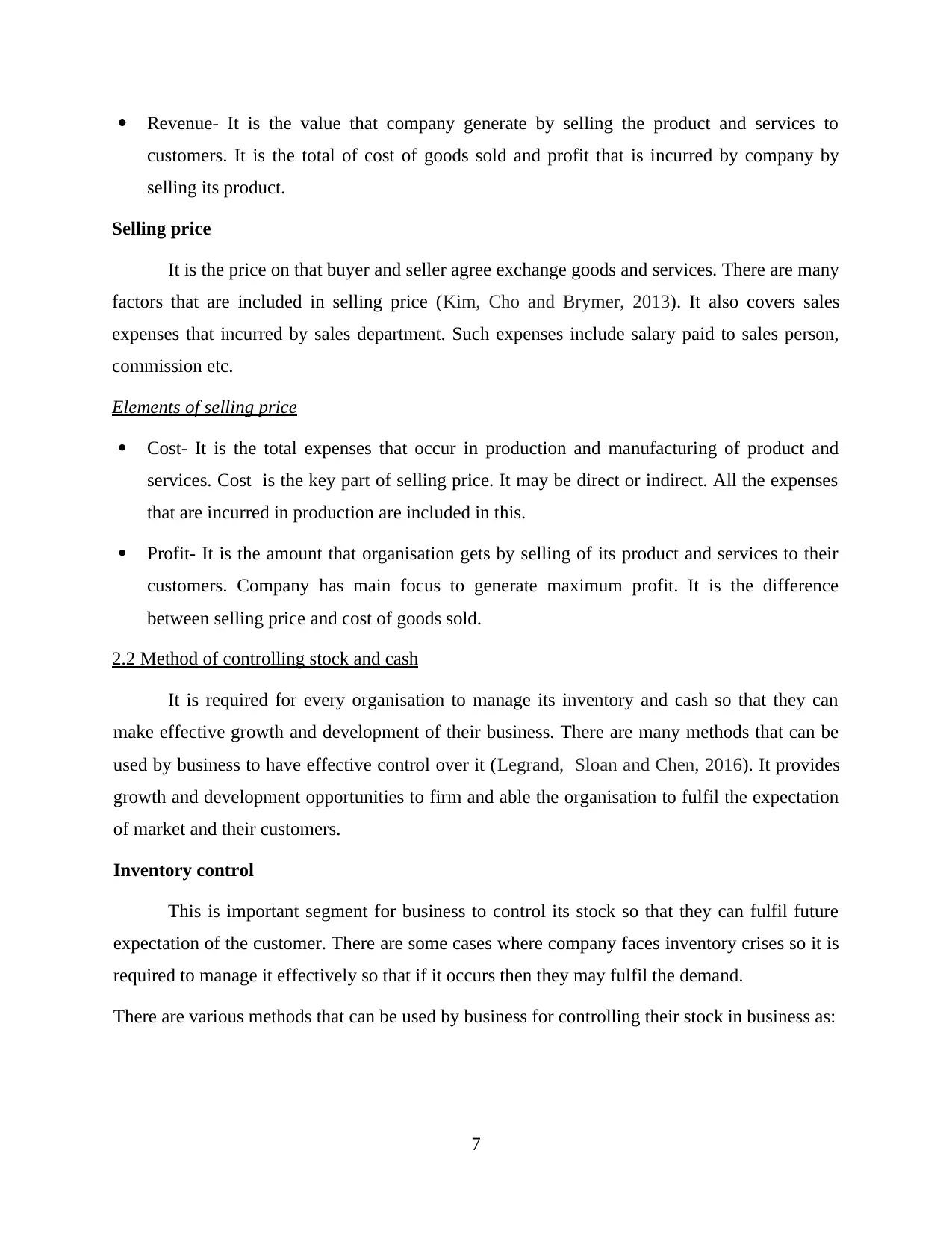
Revenue- It is the value that company generate by selling the product and services to
customers. It is the total of cost of goods sold and profit that is incurred by company by
selling its product.
Selling price
It is the price on that buyer and seller agree exchange goods and services. There are many
factors that are included in selling price (Kim, Cho and Brymer, 2013). It also covers sales
expenses that incurred by sales department. Such expenses include salary paid to sales person,
commission etc.
Elements of selling price
Cost- It is the total expenses that occur in production and manufacturing of product and
services. Cost is the key part of selling price. It may be direct or indirect. All the expenses
that are incurred in production are included in this.
Profit- It is the amount that organisation gets by selling of its product and services to their
customers. Company has main focus to generate maximum profit. It is the difference
between selling price and cost of goods sold.
2.2 Method of controlling stock and cash
It is required for every organisation to manage its inventory and cash so that they can
make effective growth and development of their business. There are many methods that can be
used by business to have effective control over it (Legrand, Sloan and Chen, 2016). It provides
growth and development opportunities to firm and able the organisation to fulfil the expectation
of market and their customers.
Inventory control
This is important segment for business to control its stock so that they can fulfil future
expectation of the customer. There are some cases where company faces inventory crises so it is
required to manage it effectively so that if it occurs then they may fulfil the demand.
There are various methods that can be used by business for controlling their stock in business as:
7
customers. It is the total of cost of goods sold and profit that is incurred by company by
selling its product.
Selling price
It is the price on that buyer and seller agree exchange goods and services. There are many
factors that are included in selling price (Kim, Cho and Brymer, 2013). It also covers sales
expenses that incurred by sales department. Such expenses include salary paid to sales person,
commission etc.
Elements of selling price
Cost- It is the total expenses that occur in production and manufacturing of product and
services. Cost is the key part of selling price. It may be direct or indirect. All the expenses
that are incurred in production are included in this.
Profit- It is the amount that organisation gets by selling of its product and services to their
customers. Company has main focus to generate maximum profit. It is the difference
between selling price and cost of goods sold.
2.2 Method of controlling stock and cash
It is required for every organisation to manage its inventory and cash so that they can
make effective growth and development of their business. There are many methods that can be
used by business to have effective control over it (Legrand, Sloan and Chen, 2016). It provides
growth and development opportunities to firm and able the organisation to fulfil the expectation
of market and their customers.
Inventory control
This is important segment for business to control its stock so that they can fulfil future
expectation of the customer. There are some cases where company faces inventory crises so it is
required to manage it effectively so that if it occurs then they may fulfil the demand.
There are various methods that can be used by business for controlling their stock in business as:
7
⊘ This is a preview!⊘
Do you want full access?
Subscribe today to unlock all pages.

Trusted by 1+ million students worldwide
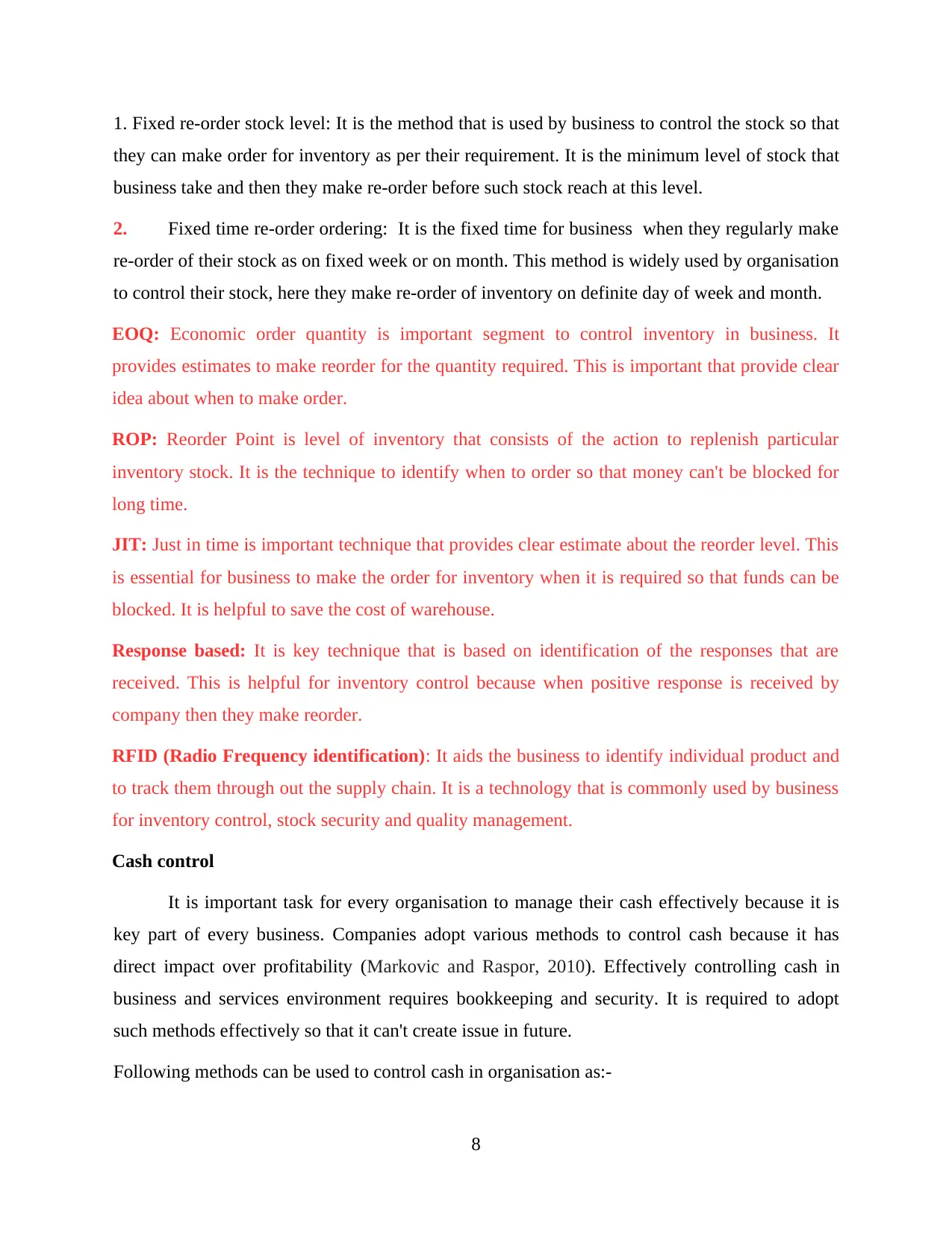
1. Fixed re-order stock level: It is the method that is used by business to control the stock so that
they can make order for inventory as per their requirement. It is the minimum level of stock that
business take and then they make re-order before such stock reach at this level.
2. Fixed time re-order ordering: It is the fixed time for business when they regularly make
re-order of their stock as on fixed week or on month. This method is widely used by organisation
to control their stock, here they make re-order of inventory on definite day of week and month.
EOQ: Economic order quantity is important segment to control inventory in business. It
provides estimates to make reorder for the quantity required. This is important that provide clear
idea about when to make order.
ROP: Reorder Point is level of inventory that consists of the action to replenish particular
inventory stock. It is the technique to identify when to order so that money can't be blocked for
long time.
JIT: Just in time is important technique that provides clear estimate about the reorder level. This
is essential for business to make the order for inventory when it is required so that funds can be
blocked. It is helpful to save the cost of warehouse.
Response based: It is key technique that is based on identification of the responses that are
received. This is helpful for inventory control because when positive response is received by
company then they make reorder.
RFID (Radio Frequency identification): It aids the business to identify individual product and
to track them through out the supply chain. It is a technology that is commonly used by business
for inventory control, stock security and quality management.
Cash control
It is important task for every organisation to manage their cash effectively because it is
key part of every business. Companies adopt various methods to control cash because it has
direct impact over profitability (Markovic and Raspor, 2010). Effectively controlling cash in
business and services environment requires bookkeeping and security. It is required to adopt
such methods effectively so that it can't create issue in future.
Following methods can be used to control cash in organisation as:-
8
they can make order for inventory as per their requirement. It is the minimum level of stock that
business take and then they make re-order before such stock reach at this level.
2. Fixed time re-order ordering: It is the fixed time for business when they regularly make
re-order of their stock as on fixed week or on month. This method is widely used by organisation
to control their stock, here they make re-order of inventory on definite day of week and month.
EOQ: Economic order quantity is important segment to control inventory in business. It
provides estimates to make reorder for the quantity required. This is important that provide clear
idea about when to make order.
ROP: Reorder Point is level of inventory that consists of the action to replenish particular
inventory stock. It is the technique to identify when to order so that money can't be blocked for
long time.
JIT: Just in time is important technique that provides clear estimate about the reorder level. This
is essential for business to make the order for inventory when it is required so that funds can be
blocked. It is helpful to save the cost of warehouse.
Response based: It is key technique that is based on identification of the responses that are
received. This is helpful for inventory control because when positive response is received by
company then they make reorder.
RFID (Radio Frequency identification): It aids the business to identify individual product and
to track them through out the supply chain. It is a technology that is commonly used by business
for inventory control, stock security and quality management.
Cash control
It is important task for every organisation to manage their cash effectively because it is
key part of every business. Companies adopt various methods to control cash because it has
direct impact over profitability (Markovic and Raspor, 2010). Effectively controlling cash in
business and services environment requires bookkeeping and security. It is required to adopt
such methods effectively so that it can't create issue in future.
Following methods can be used to control cash in organisation as:-
8
Paraphrase This Document
Need a fresh take? Get an instant paraphrase of this document with our AI Paraphraser
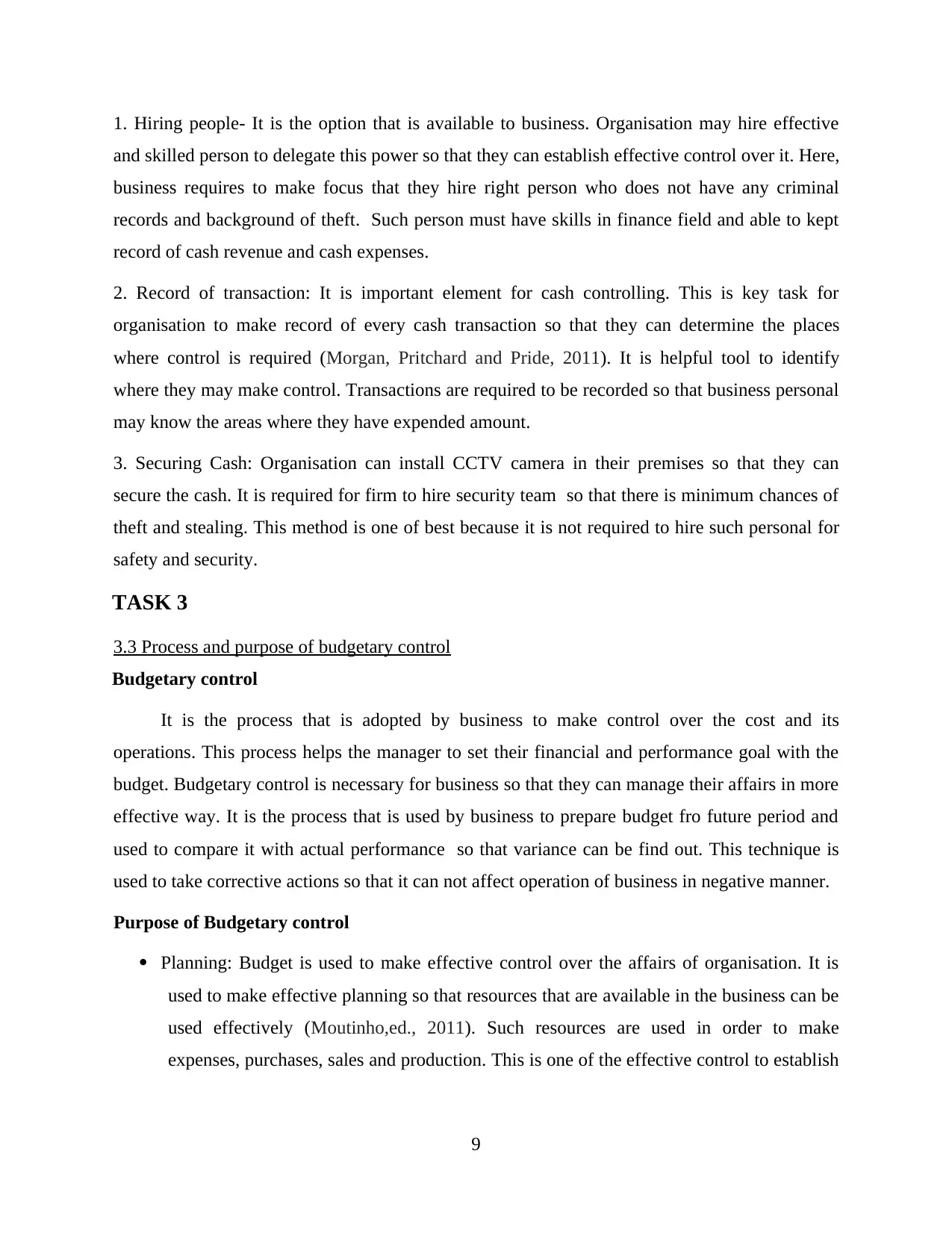
1. Hiring people- It is the option that is available to business. Organisation may hire effective
and skilled person to delegate this power so that they can establish effective control over it. Here,
business requires to make focus that they hire right person who does not have any criminal
records and background of theft. Such person must have skills in finance field and able to kept
record of cash revenue and cash expenses.
2. Record of transaction: It is important element for cash controlling. This is key task for
organisation to make record of every cash transaction so that they can determine the places
where control is required (Morgan, Pritchard and Pride, 2011). It is helpful tool to identify
where they may make control. Transactions are required to be recorded so that business personal
may know the areas where they have expended amount.
3. Securing Cash: Organisation can install CCTV camera in their premises so that they can
secure the cash. It is required for firm to hire security team so that there is minimum chances of
theft and stealing. This method is one of best because it is not required to hire such personal for
safety and security.
TASK 3
3.3 Process and purpose of budgetary control
Budgetary control
It is the process that is adopted by business to make control over the cost and its
operations. This process helps the manager to set their financial and performance goal with the
budget. Budgetary control is necessary for business so that they can manage their affairs in more
effective way. It is the process that is used by business to prepare budget fro future period and
used to compare it with actual performance so that variance can be find out. This technique is
used to take corrective actions so that it can not affect operation of business in negative manner.
Purpose of Budgetary control
Planning: Budget is used to make effective control over the affairs of organisation. It is
used to make effective planning so that resources that are available in the business can be
used effectively (Moutinho,ed., 2011). Such resources are used in order to make
expenses, purchases, sales and production. This is one of the effective control to establish
9
and skilled person to delegate this power so that they can establish effective control over it. Here,
business requires to make focus that they hire right person who does not have any criminal
records and background of theft. Such person must have skills in finance field and able to kept
record of cash revenue and cash expenses.
2. Record of transaction: It is important element for cash controlling. This is key task for
organisation to make record of every cash transaction so that they can determine the places
where control is required (Morgan, Pritchard and Pride, 2011). It is helpful tool to identify
where they may make control. Transactions are required to be recorded so that business personal
may know the areas where they have expended amount.
3. Securing Cash: Organisation can install CCTV camera in their premises so that they can
secure the cash. It is required for firm to hire security team so that there is minimum chances of
theft and stealing. This method is one of best because it is not required to hire such personal for
safety and security.
TASK 3
3.3 Process and purpose of budgetary control
Budgetary control
It is the process that is adopted by business to make control over the cost and its
operations. This process helps the manager to set their financial and performance goal with the
budget. Budgetary control is necessary for business so that they can manage their affairs in more
effective way. It is the process that is used by business to prepare budget fro future period and
used to compare it with actual performance so that variance can be find out. This technique is
used to take corrective actions so that it can not affect operation of business in negative manner.
Purpose of Budgetary control
Planning: Budget is used to make effective control over the affairs of organisation. It is
used to make effective planning so that resources that are available in the business can be
used effectively (Moutinho,ed., 2011). Such resources are used in order to make
expenses, purchases, sales and production. This is one of the effective control to establish
9
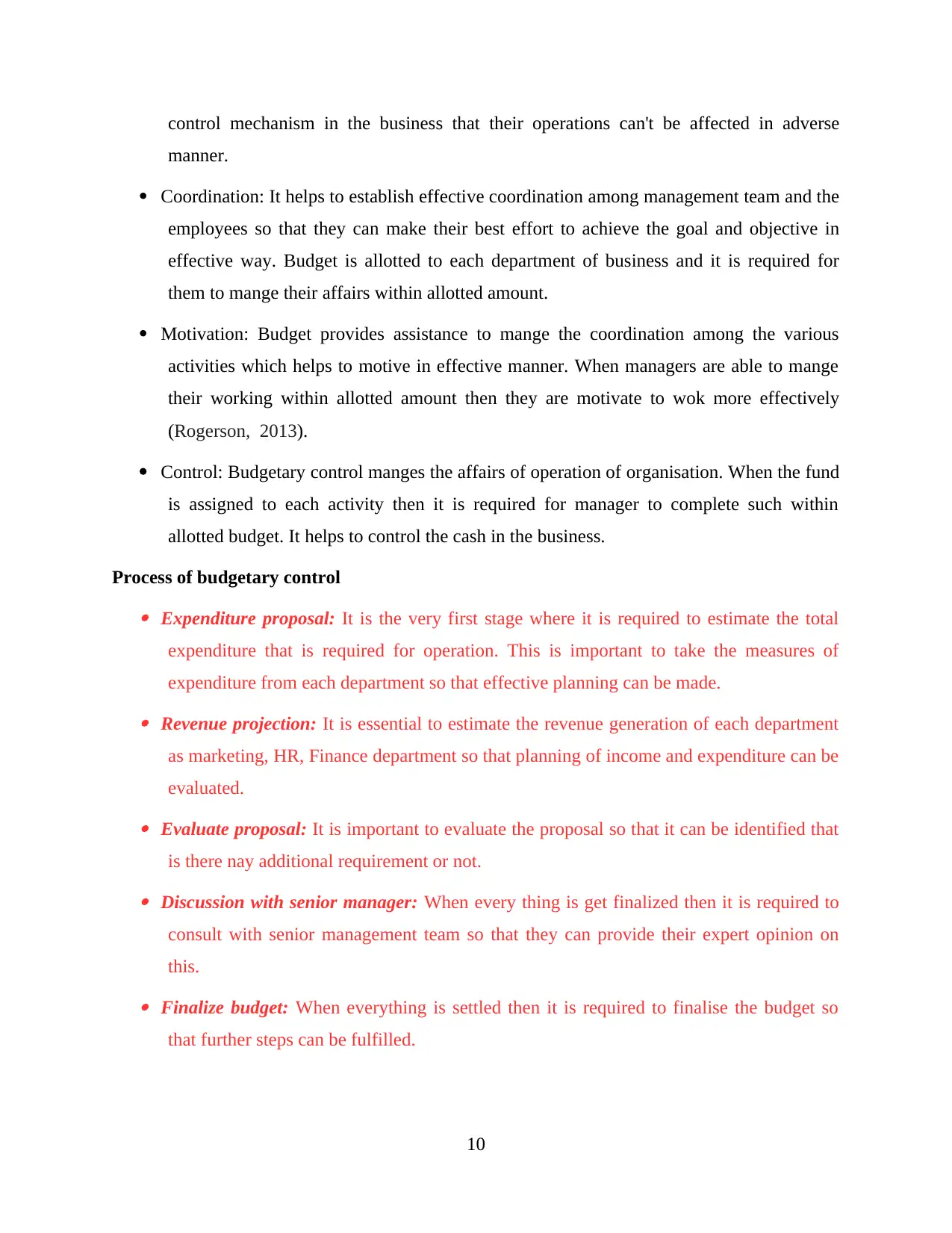
control mechanism in the business that their operations can't be affected in adverse
manner.
Coordination: It helps to establish effective coordination among management team and the
employees so that they can make their best effort to achieve the goal and objective in
effective way. Budget is allotted to each department of business and it is required for
them to mange their affairs within allotted amount.
Motivation: Budget provides assistance to mange the coordination among the various
activities which helps to motive in effective manner. When managers are able to mange
their working within allotted amount then they are motivate to wok more effectively
(Rogerson, 2013).
Control: Budgetary control manges the affairs of operation of organisation. When the fund
is assigned to each activity then it is required for manager to complete such within
allotted budget. It helps to control the cash in the business.
Process of budgetary control Expenditure proposal: It is the very first stage where it is required to estimate the total
expenditure that is required for operation. This is important to take the measures of
expenditure from each department so that effective planning can be made. Revenue projection: It is essential to estimate the revenue generation of each department
as marketing, HR, Finance department so that planning of income and expenditure can be
evaluated. Evaluate proposal: It is important to evaluate the proposal so that it can be identified that
is there nay additional requirement or not. Discussion with senior manager: When every thing is get finalized then it is required to
consult with senior management team so that they can provide their expert opinion on
this. Finalize budget: When everything is settled then it is required to finalise the budget so
that further steps can be fulfilled.
10
manner.
Coordination: It helps to establish effective coordination among management team and the
employees so that they can make their best effort to achieve the goal and objective in
effective way. Budget is allotted to each department of business and it is required for
them to mange their affairs within allotted amount.
Motivation: Budget provides assistance to mange the coordination among the various
activities which helps to motive in effective manner. When managers are able to mange
their working within allotted amount then they are motivate to wok more effectively
(Rogerson, 2013).
Control: Budgetary control manges the affairs of operation of organisation. When the fund
is assigned to each activity then it is required for manager to complete such within
allotted budget. It helps to control the cash in the business.
Process of budgetary control Expenditure proposal: It is the very first stage where it is required to estimate the total
expenditure that is required for operation. This is important to take the measures of
expenditure from each department so that effective planning can be made. Revenue projection: It is essential to estimate the revenue generation of each department
as marketing, HR, Finance department so that planning of income and expenditure can be
evaluated. Evaluate proposal: It is important to evaluate the proposal so that it can be identified that
is there nay additional requirement or not. Discussion with senior manager: When every thing is get finalized then it is required to
consult with senior management team so that they can provide their expert opinion on
this. Finalize budget: When everything is settled then it is required to finalise the budget so
that further steps can be fulfilled.
10
⊘ This is a preview!⊘
Do you want full access?
Subscribe today to unlock all pages.

Trusted by 1+ million students worldwide
1 out of 26
Related Documents
Your All-in-One AI-Powered Toolkit for Academic Success.
+13062052269
info@desklib.com
Available 24*7 on WhatsApp / Email
![[object Object]](/_next/static/media/star-bottom.7253800d.svg)
Unlock your academic potential
Copyright © 2020–2025 A2Z Services. All Rights Reserved. Developed and managed by ZUCOL.




